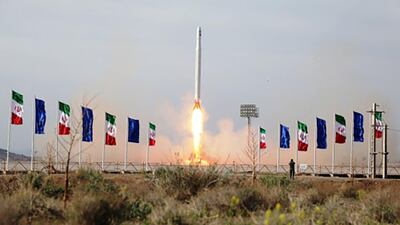Iran’s progress towards a possible nuclear weapon has continued unaffected by the Covid-19 outbreak, satellite imagery has shown.
The commercially available footage of four Iranian facilities, analysed by Jane’s intelligence, showed Iran’s nuclear activity has not slowed during the pandemic.
The activity and launch at the Shahrud Missile Test Complex in particular indicated that Iran’s missile and space programmes remained largely unaffected by the Covid-19 pandemic, according to Jane’s.
In April, as Tehran grappled with the coronavirus outbreak, the Islamic Revolutionary Guard Corps launched its first satellite into space, revealing what experts described as a secret military space programme that could advance its ballistic missile development.
The continued missile activity followed Iran’s move to all but abandon the limitations of its 2015 nuclear deal with world powers.
US President Donald Trump unilaterally withdrew America from the agreement known as the Joint Comprehensive Plan of Action (JCPOA) in 2018.
Mr Trump’s decision to renege on the deal set off a series of escalating attacks that culminated in a US drone strike in January that killed Iranian general Qassem Suleimani in Iraq. In retaliation, Tehran launched a ballistic missile attack aimed at American soldiers stationed in Iraq.
Jane's noted that the new generation of centrifuges, scheduled to be unveiled at the Iranian nuclear facility at Natanz in Isfahan Province, could be in violation of the JCPOA restrictions.
The emergence of a new generation of centrifuges was likely to raise concerns about Iran’s persistent breach of the JCPOA limitations.
“Heightened diplomatic and military tensions between Tehran and Washington in April are likely to continue as the Covid-19 pandemic settles in the following months,” said Srishti Punja, an analyst at Jane’s.
“There is a somewhat high risk of escalation of tensions and direct confrontation between Iran and the US in the Gulf, which has remained subdued since the confrontations in January 2020.”
Iran has been hit harder than any other nation in the Middle East by the Covid-19 pandemic. The country has recorded more than 109,000 cases of the disease and 6,685 deaths during the outbreak, although the figures are believed to be much higher.
A friendly fire incident between Iranian naval vessels on Monday brought renewed attention to Iranian missile development.
One Iranian warship accidentally struck another with a missile during a test, killing 19 sailors and wounding 15 others.
The incident took place during training in the Gulf of Oman, a waterway that connects to the Strait of Hormuz. Iran regularly conducts exercises in the area, which has been the backdrop to increasing tensions between Tehran and Washington.














